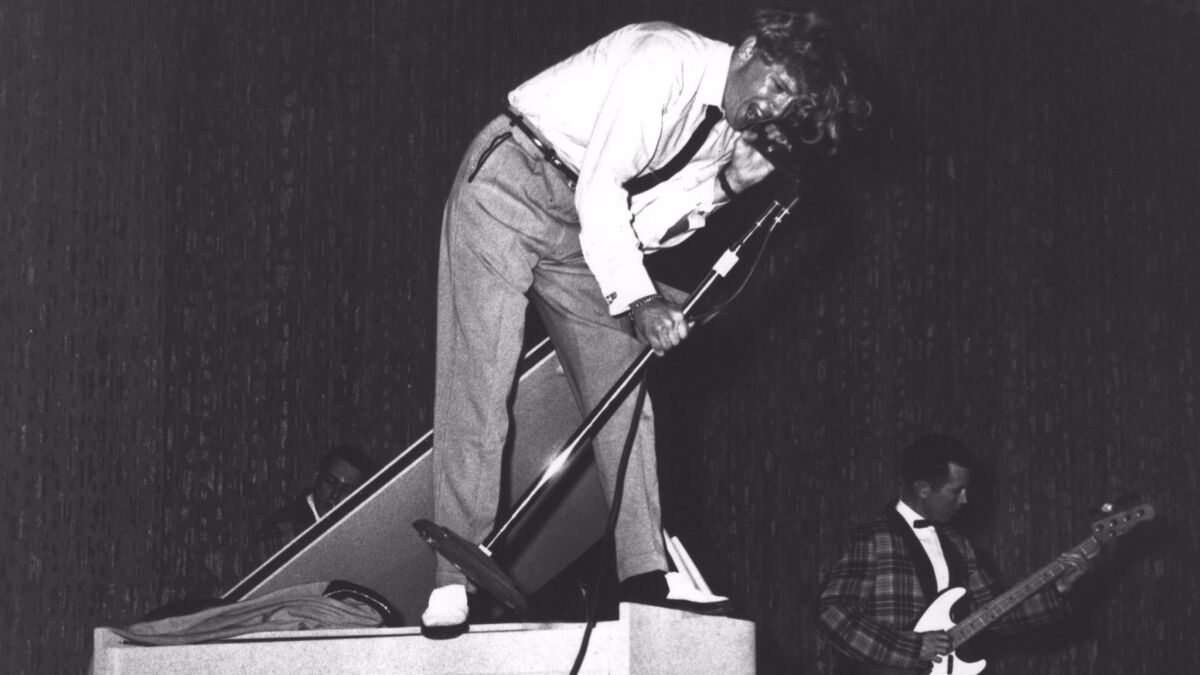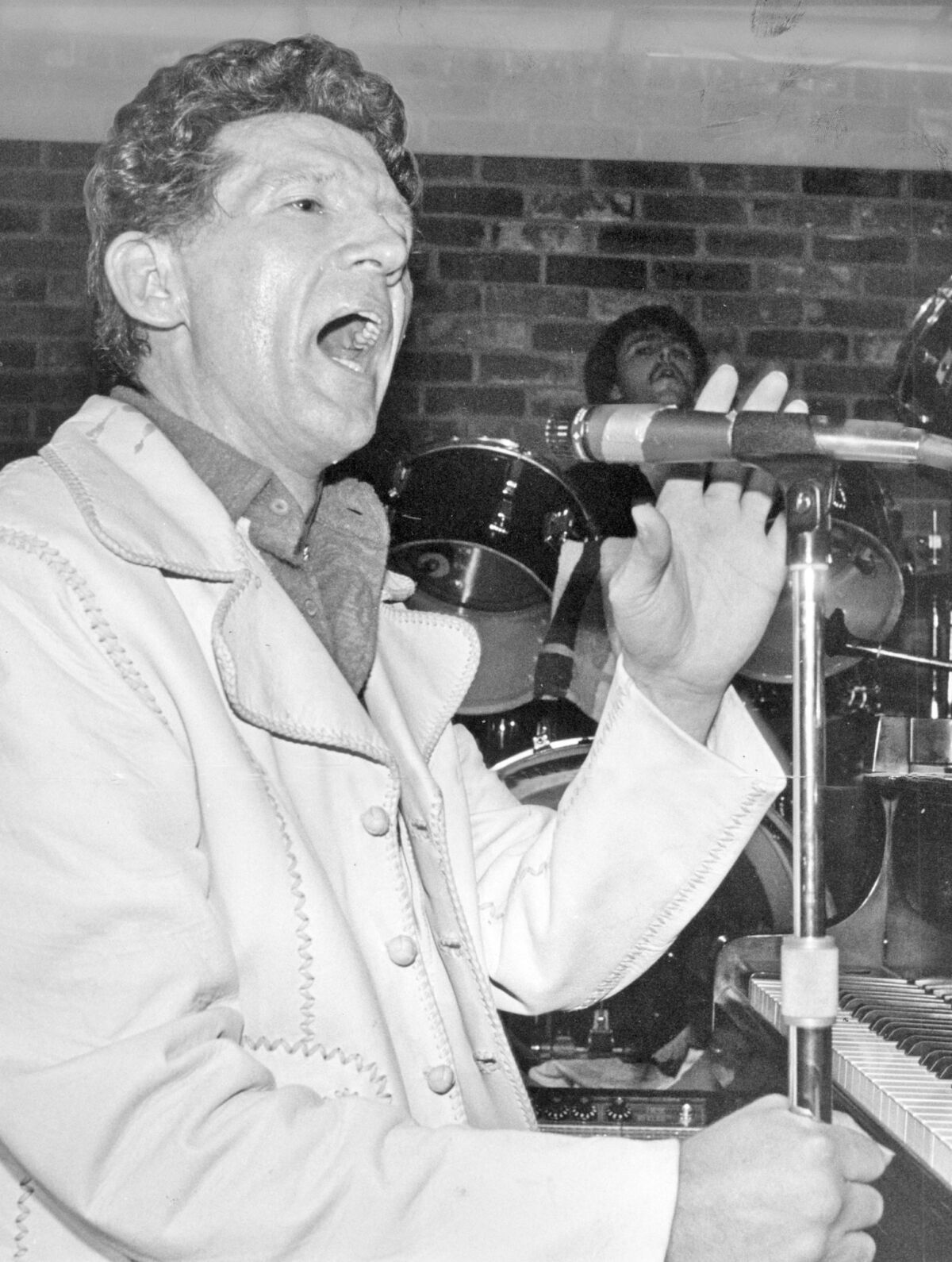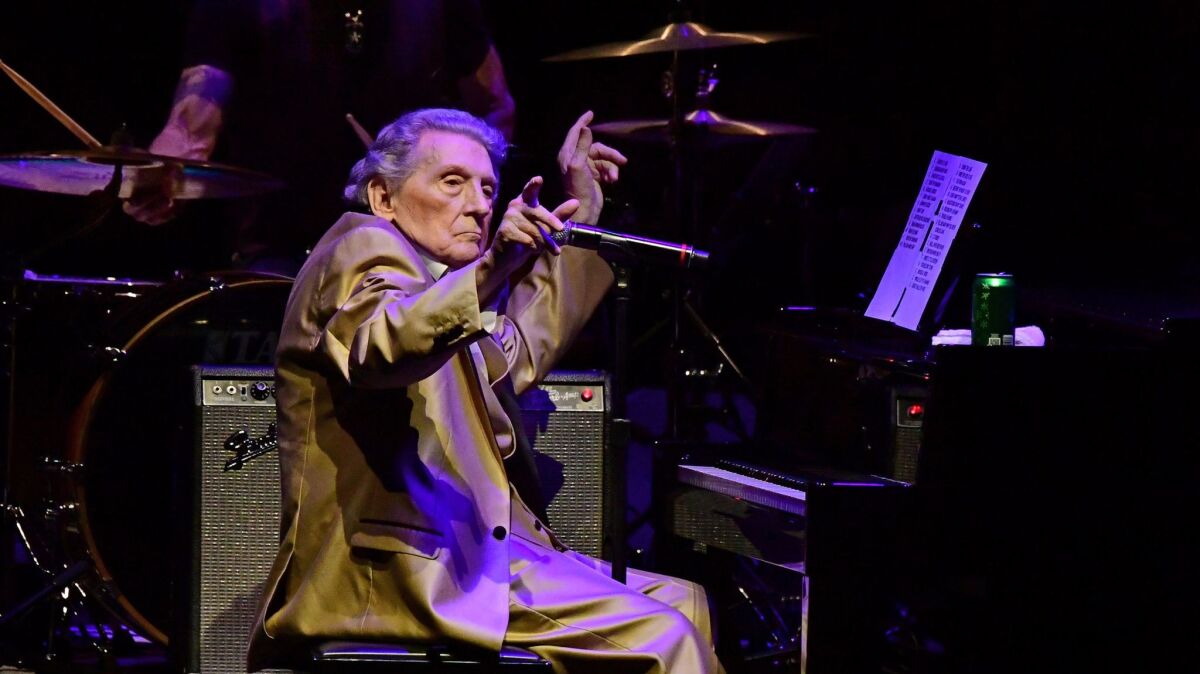Jerry Lee Lewis, original wild man of rock ‘n’ roll, has died
Jerry Lee Lewis, the original wild man of rock ‘n’ roll whose explosive records, fiery performances and real-life scandals made him one of the genre’s most fascinating and fearsome figures, died Friday. He was 87.
Lewis’ publicist announced the singer’s death in a statement, following a premature report of his demise from TMZ earlier in the week.
The cause of death was not revealed. Lewis had been hospitalized in early 2019 after suffering a stroke, forcing him to cancel his planned spring and summer concerts.
A brash backwoods maverick with a wavy blond pompadour and an arrogant sneer, Lewis brought nervy authority and a personal stamp to his unruly concoction of country, gospel and rhythm and blues.
The singer-pianist’s first two hits, “Whole Lotta Shakin’ Goin’ On” and “Great Balls of Fire,” were definitive incarnations of rock ‘n’ roll’s primal allure.
John Lennon referred to “Whole Lotta Shakin’” as “the perfect rock ‘n’ roll record.” Elton John adopted Lewis’ signature maneuver of kicking the piano bench across the stage.
But Lewis’ influence transcended the music. He was the prototype of the hard-rocking, hard-living renegade, and his example of audacity and independence became a part of rock’s DNA.
His music and his life also embraced some of the great dichotomies of the American experience — notably, the interplay between Black and white America that his music embodied, and the conflict between spirit and flesh that arose from his upbringing in a Pentecostal church.
Lewis is considered one of the key founders of rock ‘n’ roll, along with Elvis Presley, Chuck Berry and Little Richard. He was a charter inductee in the Rock and Roll Hall of Fame in 1986 and received a lifetime achievement award from the Recording Academy at the 2005 Grammys. In 2022, he was inducted into the Country Music Hall of Fame.
“He’s the only guy, other than Ray Charles, who sings country and rock ‘n’ roll authentically,” said singer-songwriter Kris Kristofferson, a longtime friend. “I don’t think he’s gotten the credit for how good he really is. I’m sure that he ranks right up there with Frank Sinatra and all the great American singers.”
Despite his musical success, Lewis was relentlessly self-destructive yet seemingly indestructible. His life was strewn with tragedy (the deaths of a brother, two children and two wives), excess (drinking and drug use triggered two near-fatal ailments), tax problems and sheer recklessness — he accidentally shot his bassist in the chest, and he was arrested for packing a pistol and drunkenly driving his car into the gates of Elvis Presley’s Graceland estate.
Yet, somehow, Lewis survived, outlasting nearly all his peers. Even after his rock ‘n’ roll career was derailed when he married his 13-year-old cousin in 1957, he rebranded himself as a country singer in 1968 and occupied the charts for 15 more years.

Jerry Lee Lewis, performing in his prime, sings atop a piano. His mother sent him to study for the ministry when he was 15, but honky-tonk music ultimately claimed his soul.
(UPI/Bettman Newsphotos)
Jerry Lee Lewis was born Sept. 29, 1935, in Ferriday, La., a small farming and sawmill community on the Mississippi River. His father, Elmo, was a cotton farmer and bootlegger who did time in jail. His mother, Mamie, was a deeply religious woman who was known to speak in tongues during church services.
The couple’s oldest child, Elmo Jr., was struck and killed by a drunk driver when he was 9. Jerry Lee grew up with his younger sisters Linda Gail and Frankie Jean and shared a powerful interest in music with two cousins — Jimmy Lee Swaggart and Mickey Gilley — who would later gain fame as a televangelist and country star, respectively.
Lewis absorbed country music through his father’s Jimmie Rodgers records and the radio broadcasts of “The Grand Ole Opry” and “Louisiana Hayride,” where he discovered the young Hank Williams. The music at the Assemblies of God Church that his family attended and where he frequently played ran toward the intense and rapturous.
At the movies, he loved the cowboy songs of Gene Autry. Before one screening, he heard Al Jolson’s “Down Among the Sheltering Palms” and was deeply impressed. Lewis later became a regular, if unauthorized, visitor to Haney’s Big House, Ferriday’s lone hotspot for touring blues and R&B acts, and he sampled more blues on forays into the town’s Black neighborhoods.
Lewis once proclaimed that there were only four true musical “stylists” — Rodgers, Jolson, Williams and, of course, himself.
When he was 8, his parents mortgaged their small house and bought Lewis a used upright piano. He practiced constantly, developing a command of the keyboard that would serve him throughout his career.
A high-spirited, trouble-prone boy who frequently skipped school, Lewis was called “Killer” by friends, a casual nickname that would assume ominous overtones later in life.
He gave his first performance at 13, at the opening of a Ford dealership. The youngster went on to play wherever possible — in church, at dances, on the radio and later at clubs.
When he was 15 he attended the Southwestern Bible Institute in Waxahachie, Texas, with thoughts of becoming a minister. He was expelled after one year.
Couples married young in Ferriday, and Lewis took the plunge when he was 16 and his wife, a preacher’s daughter, a year older. It lasted eight months and overlapped his second marriage, to Jane Mitcham. Their son, Jerry Lee Jr., would die in a Jeep accident in 1973 at 19.
Lewis sold sewing machines door to door, auditioned unsuccessfully in Nashville and Louisiana, and played as he could at regional clubs. When he heard Presley’s hit “That’s All Right” in 1954, he decided that he belonged at Sun Records, Elvis’ original label.
Sam Phillips, the visionary owner at Sun, was out of town when Lewis arrived unannounced at the storefront studio in Memphis, Tenn., but his assistant Jack Clement took notice when the youngster proclaimed that he could play the piano the way Chet Atkins played the guitar.
Years later, Phillips recalled the first time he heard Lewis’ tapes.
“I said who is this cat?” he is quoted as saying in Lewis’ 1993 autobiography, “Killer!” “Because it was all there in abundance — as spontaneous as anything I had ever listened to. I didn’t care how raw it was. I didn’t give a damn how unpolished it was. To hear that core, that soul, that heart and that freedom floating around. That’s the way I listened to people and knew they was special.”
Lewis and Clement started out with some country songs, and his version of Ray Price’s hit “Crazy Arms” became a regional success.
Lewis’ second single was a song that he had played regularly in his live act for years. He endowed the recording of Roy Hall and Dave Williams’ “Whole Lotta Shakin’ Goin’ On” with a massive dose of personality and a playful, leering eroticism.

Jerry Lee Lewis performs at a club in Longview, Texas, in 1981.
(Los Angeles Times archives)
“It wasn’t a dirty record to me,” Lewis said in a 1981 interview with The Times. “It wasn’t a religious song either, mind you, but I didn’t think it was dirty.”
It was an overly erotic record to many, however, and airplay was limited until Lewis performed it on Steve Allen’s Sunday night NBC variety show. It quickly reached No. 2 on the pop chart and No. 1 on the country and R&B charts.
His next single, released in late 1957, was “Great Balls of Fire,” an enduring touchstone of rock ‘n’ roll that infused carnality with a spiritual fervor. It was another smash, and when his next single, “Breathless,” became his third straight hit, Lewis was poised to become rock ‘n’ roll’s leading man.
In May 1958 he flew to England for a tour that was intended to affirm his primacy but ended up sending him into exile. Reporters met him at the airport in London to cover his arrival and inquired about the young woman in his entourage. Lewis introduced her as his 13-year-old wife, and all hell broke loose.
Lewis had married Myra Gail Brown in December 1957, the culmination of a romance that bloomed when he moved into the Memphis home of Myra’s father, JW Brown, who was Lewis’ cousin and bass player.
The press came down hard on him, especially when it was revealed that Myra was his second cousin and that he was still married when they wed.
Amid uproar and outrage, the tour was canceled after just three dates. Back in the U.S., Lewis was unable to get airplay on the radio stations he had recently dominated. His next record, “High School Confidential,” stalled at No. 21 on the pop chart.
Major concert bookings also dried up, and Lewis began playing small venues that he had long outgrown. He made the Top 30 with a version of Ray Charles’ “What’d I Say,” but his days with Sun were numbered, and in 1963 he signed with Mercury Records’ Smash label.
He recorded prolifically for years, and though he was absent from the charts, he maintained his high standards. In 1968 Lewis seemed ready for new directions. He played the role of Iago in “Catch My Soul,” a musical based on “Othello” that was staged at the Ahmanson Theatre in Los Angeles.
The same year, producer Eddie Kilroy suggested that Lewis try a straight country recording. The honky-tonk ballad “Another Place, Another Time” brought him back, launching a phase that produced 22 Top 10 country singles over 15 years, including “What’s Made Milwaukee Famous (Has Made a Loser Out of Me),” “Middle Age Crazy” and “Thirty Nine and Holding.”
But as he enjoyed renewed success, his personal problems escalated.
His marriage to Myra was strained by the 1962 drowning death of their 3-year-old son, Steve Allen Lewis, and ended in divorce in 1970. Her memoir, “Great Balls of Fire,” was made into a 1989 movie starring Dennis Quaid and Winona Ryder as the famous couple.
Lewis married Jaren Gunn in 1971, and two years after their 1980 divorce, she drowned in a swimming pool accident.
People have been trying for 30 years to show that I’m the wrong kind of person. But justice will catch up with them.
— Jerry Lee Lewis, 1984
In 1975 Lewis was arrested for shooting up his Nashville office, and the following year there was more gun trouble when he accidentally shot his bassist Norman “Butch” Owens with a ricocheting bullet that he had aimed at a bottle.
Two months later came the bizarre Graceland incident, in which an intoxicated Lewis pulled up and slammed into Elvis’ gate with his new Lincoln, while in possession of a revolver.
Lewis later said that Presley had called and asked him to come over, and that the gun had been given to him as a gift by a club owner earlier that night.
Lewis’ fifth wife, Shawn Stephens, died in the bedroom of their Nesbit, Miss., ranch less than three months after their June 1983 marriage. Officially, her death was blamed on an accidental overdose of methadone, but suspicions dogged Lewis. Rolling Stone magazine and ABC’s “20/20” both raised questions about the circumstances and the investigation, but Lewis steadfastly maintained his innocence.
“They’re trying to slaughter me,” he told The Times in 1984. “But I’m used to it. People have been trying for 30 years to show that I’m the wrong kind of person. But justice will catch up with them. My conscience is clear.”
The Internal Revenue Service periodically confiscated his possessions because of a mounting tax debt. He was acquitted of income tax evasion in 1984, and in 1992 moved to Dublin after being hit with a $1.4-million tax lien. He ultimately settled and returned to the U.S., but also filed for bankruptcy — twice.
The wear and tear of his fast living and prodigious intake of alcohol, amphetamines and sedatives caught up with him in 1981, when he underwent surgery for a stomach perforation, followed by an operation for a subsequent infection.
Shortly afterward, Lewis was swigging from a whiskey bottle during an interview with The Times, and he returned to the critical list in 1985 with bleeding ulcers.
Lewis said he finally quit drinking in the mid-1990s, and kicked painkillers a decade after that.
His life became more low-key, alternating between concert dates and down time at his ranch near Memphis, where he enjoyed watching television, especially “Gunsmoke” reruns. Phoebe Lewis, his daughter with Myra, tended to his career, and his sixth marriage, to 21-year-old Kerrie McCarver Mann, produced a son, Jerry Lee Lewis III, in 1987. They divorced in 2005.

At age 82, Jerry Lee Lewis performs at the Theatre at the Ace Hotel in Los Angeles on Nov. 24, 2017.
(Hal Wells / Los Angeles Times)
In 2012 Lewis married his seventh wife, Judith Ann Coghlan Brown. She was the ex-wife of his cousin Rusty Brown, the younger brother of Myra, Lewis’ third wife.
Lewis’ career tailed off after his country chart run ended. In the ‘80s and ‘90s he recorded for a variety of labels without much success. Los Angeles movie producer and real estate heir Steve Bing financed “Last Man Standing,” a 2006 release that paired Lewis with such rock stars as Bruce Springsteen, Mick Jagger, John Fogerty, Keith Richards and Jimmy Page. It was Lewis’ second outing with his rock disciples, following his London-recorded “Sessions” album from 1973.
In 2017, Lewis played before thousands at Stagecoach in Coachella Valley and, in a far more intimate setting, at the Theatre at the Ace Hotel in Los Angeles. Dressed in a gold suit, he spun through his classics, gingerly tipped over his piano bench after the finale and grabbed a gold cane before shuffling off stage.
While rock was a music and culture he had shaped profoundly, Lewis often spoke about turning to the ministry and singing only gospel songs — forever torn between the sacred and the profane.
“You can’t straddle the fence,” he said in a 1981 interview with The Times. “The way I believe it is you’ve got to be on one side or the other. You can’t serve two gods. Satan is pretty strong, though…. You’ve got to rock or you’ve got to preach. You can’t do them both.”
Lewis is survived by his wife, Judith Coghlan Lewis; his children Jerry Lee Lewis III, Ronnie Lewis, Pheobe Lewis and Lori Lancaster; sister Linda Gail Lewis; cousin Jimmy Swaggart; and many grandchildren, nieces and nephews.
Cromelin is a former Times music critic.
For all the latest Entertainment News Click Here
For the latest news and updates, follow us on Google News.
